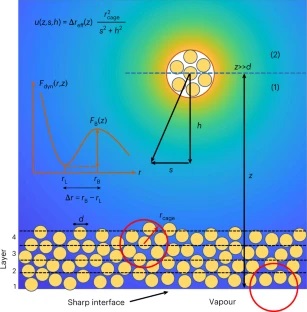
近日,美国南佛罗里达大学David S.Simmons课题组与伊利诺伊大学的Kenneth S.Schweizer等合作,研究了动态梯度中表面诱导的长尾集体弹性玻璃物理的特征。相关成果已于2023年3月23日在国际权威学术期刊《自然—物理学》上发表。
该研究团队发现,界面附近的玻璃转变温度和结构弛豫时间的空间梯度形式确实提供了块状玻璃形成液体弛豫本质的迹象。他们对支撑在动态中性基底上、具有一个蒸汽界面的厚玻璃聚合物薄膜进行了长时间大系统分子动力学模拟,并发现蒸汽界面核化的玻璃转变温度和结构弛豫时间梯度表现出两个不同的区域:一个中程的、大振幅的指数梯度,后面是一个长程缓慢衰减的尾部,可以用反幂定律来描述。
这种行为与多种提出的玻璃动态学理论不符,但是根据“弹性集体非线性朗之万方程”理论预测,它是两个耦合机制的结果——一个中程的界面核化梯度的表面修正局部笼约束和一个截断长程集体弹性场的界面。这些发现支持一种耦合的空间局部-非局部机制,包括在各向同性体积和破坏的对称薄膜中激活的玻璃松弛和动力学玻璃化。
研究人员表示,理解驱动块状玻璃转变的动态关联的基本性质一直是一个长期存在的问题。
附:英文原文
Title: Signature of collective elastic glass physics in surface-induced long-range tails in dynamical gradients
Author: Ghanekarade, Asieh, Phan, Anh D., Schweizer, Kenneth S., Simmons, David S.
Issue&Volume: 2023-03-23
Abstract: Understanding the underlying nature of dynamical correlations believed to drive the bulk glass transition is a long-standing problem. Here we show that the form of spatial gradients of the glass transition temperature and structural relaxation time near an interface indeed provide signatures of the nature of relaxation in bulk glass-forming liquids. We report the results of long-time, large-system molecular dynamics simulations of thick glass-forming polymer films with one vapour interface, supported on a dynamically neutral substrate. We find that gradients in the glass transition temperature and logarithm of the structural relaxation time nucleated at a vapour interface exhibit two distinct regimes: a medium-ranged, large-amplitude exponential gradient, followed by a long-range slowly decaying tail that can be described by an inverse power law. This behaviour disagrees with multiple proposed theories of glassy dynamics but is predicted by the ‘elastically collective nonlinear Langevin equation’ theory as a consequence of two coupled mechanisms: a medium-ranged interface-nucleated gradient of surface-modified local caging constraints, and an interfacial truncation of a long-ranged collective elastic field. These findings support a coupled spatially local–nonlocal mechanism of activated glassy relaxation and kinetic vitrification in both the isotropic bulk and in broken-symmetry films.
DOI: 10.1038/s41567-023-01995-8
Source: https://www.nature.com/articles/s41567-023-01995-8
